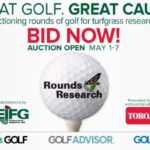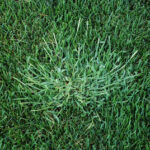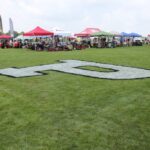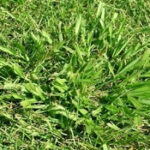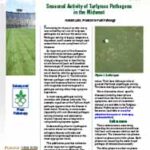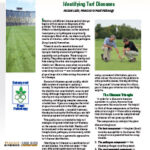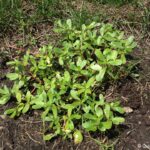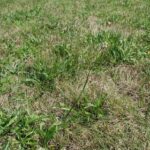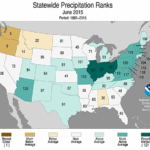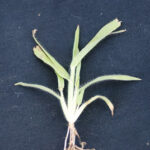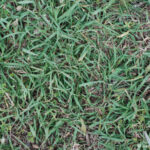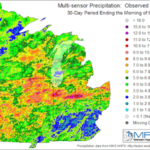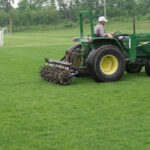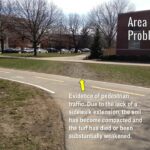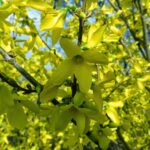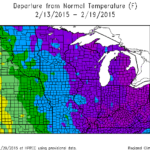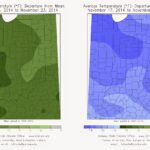Turf Professional
Rounds 4 Research: Auction is Open until May 7. Support the Purdue Turf Program
The 2017 Rounds 4 Research auction is now open. The auction is open May 1-7, 2017 with proceeds going to support turf research at Purdue University and in Indiana through the Midwest Regional Turf Foundation. Fundraising supports research and education programs for the benefit of golf course management professionals, golf facilities, and the game. This […]
Crabgrass is out in full force in 2016!
Why is crabgrass so bad this year? Several factors contribute to a bad year for crabgrass. Crabgrass is a warm-season grass meaning that it thrives in hot conditions with optimum growth in temperatures ranging from 88 to 95 °F. However, our primary lawn species in Indiana are cool-season grasses and they prefer cooler conditions and […]
Lawn Diseases 2016
The summer of 2016 has been quite favorable for the development of an assortment of infectious diseases on residential turf. The primary driver of all of this disease activity is the weather. In the lower Midwest, the combination of elevated temperature and ample precipitation since the beginning August of has spawned outbreaks of brown patch, […]
Turfgrass Insects: Managing White Grubs in Turfgrass (E-271-W)
Purdue Extension Publication
This publication provides Indiana turfgrass management professionals and property owners with information to help them (1) properly identify the most common white grub species, (2) understand white grub biology, (3) recognize white grub damage, and (4) formulate safe and effective management strategies.
Turf and Landscape Field Day on July 12, 2016
On Tuesday, July 12, 2016 the Purdue Turf Program and the Midwest Regional Turf Foundation will host the Turf and Landscape Field Day. The Turf and Landscape Field Day is Indiana’s largest green industry field day. This will be the third year with landscape research tours added. Specialists from four different departments in the College […]
Field Paspalum
Field Paspalum Biology: Field paspalum (Paspalum laeve Michx.) is a warm-season perennial weed with short rhizomes similar to dallisgrass (Paspalum dilatatum Poir.). Much of the below Weed of the Month entry comes from research conducted in Indiana on how to control Field Paspalum. That research was published in 2012. Reicher, Z.J., A.J. Patton, and […]
Turfgrass Disease Profiles: Seasonal Activity of Turfgrass Pathogens (BP-125-W)
Purdue Extension Publication
Understanding when turf pathogens are active allows turf managers to anticipate disease outbreaks and schedule fungicide applications at the most appropriate times. This publication provides estimates of when important turf pathogens are active in the lower Midwest.
Turfgrass Disease Profiles: Turf Disease Identification (BP-124-W)
Purdue Extension Publication
This publication will help turf managers know what to look for when they diagnose infectious turf diseases on the course and in the field. Readers will understand the components of the disease triangle (host, pathogen, and environment), and then be able to use that concept to develop a systematic approach identifying turf disease.
Common Purslane
Purslane Biology: Common purslane (Portulaca oleracea L.) is a summer annual broadleaf weed (Fig. 1) that is commonly found in low maintenance turf swards (Fig. 2), turf seeded in summer (Fig. 3), next to sidewalks and driveways, and in mulched beds and gardens (Fig. 4). Purslane is a succulent plant with a prostrate growth habit, […]
Look Out for Herbicide Resistant Weeds in Turf
Herbicide resistance can be defined as the acquired ability of a weed population to survive an herbicide application that previously was known to control the population. The number of herbicide resistant weeds has been rapidly increasing in agriculture in recent years. Currently, 459 unique cases of herbicide resistant weeds exist globally, with 246 species (143 […]
What’s Next in the Forecast?
June 2015 was the wettest month on record in Indiana, Illinois, and Ohio, but I don’t have to tell you that if you live in one of these states as you’ve experienced it firsthand. But what’s next? Here are some predictions of what we might face weather-wise in the upcoming weeks and months. Precipitation: […]
Postemergence Crabgrass Control
As crabgrass grows larger and larger this spring into summer, you’ll need to know just how big it is before selecting the right product for postemergence control. Read my recent article to turf professionals at Turf Republic: Just How Big is Your Crabgrass? For homeowners, look for products that contain quinclorac such […]
Quackgrass
Quackgrass Biology: Quackgrass ( Elymus repens) is a cool-season perennial that vigorously spreads by rhizomes. It is a sod-forming grass that can crowd out desirable grasses and even other weeds. Quackgrass has been shown to be allelopathic, which means it releases chemicals that inhibit the growth of other plants. Large, nearly pure patches of […]
Rain, Rain Go Away?
There are a lot of wet areas out there right now as pockets of Indiana have received more than double their monthly expected rainfall. Rain is a good thing but as we know it is possible to have too much of a good thing. Saturated soils reduce turf health and cause issues related to mowing […]
Is it Safe to Aerify after Applying a Preemergence Herbicide?
It is not uncommon for me to receive questions regarding whether it is OK to aerify an area when you’ve already applied a preemergence herbicide to control crabgrass. Will aerifying break the herbicide barrier and reduce my crabgrass control? The answer to this and more can be found here in a recent post I wrote […]
How to Keep Turf Areas Around Sidewalks From Failing
Last year I posted a turf tip on why it is so difficult to manage turf around sidewalks and driveways. I encourage you to read that post (Weed Management Next to Sidewalks and Driveways) as it provides recommendations for weed control, etc. in these areas as well as how to prevent weeds and encourage healthier […]
Common Questions About Crabgrass Germination and Preemergence Herbicides Answered
This time of year many have questions about crabgrass germination and control. Below are several previous Purdue turf tips that answer the most commonly asked questions about crabgrass control. When will crabgrass germinate? When should I apply my preemergence herbicide (crabgrass preventer)? Which preemergence herbicide should I use? – Professionals How to Select a Crabgrass […]
This Week Felt Too Much Like 2014!
This cold weather reminded me of the cold weather we experienced last winter. While it is too early to tell what effect the weather might have had on the turf, it could have damaged some warm-season turf areas in north central Indiana (like our bermudagrass and zoysiagrass areas at the Daniel Turf Research Center) where […]
Is it Too Late to Apply My Last Nitrogen Fertilization?
Fall is an important time to fertilizer our cool-season turfgrasses. Fall nitrogen promotes good root development, enhances storage of energy reserves, and extends color retention in cool-season lawns. Most of the benefits from late fall nitrogen will be seen next spring and summer with earlier green-up, improved turf density, and improved tolerance to spring diseases […]
